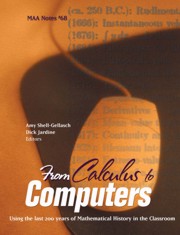Book contents
- Frontmatter
- Preface
- Contents
- Introduction
- I Algebra, Number Theory, Calculus, and Dynamical Systems
- II Geometry
- III Discrete Mathematics, Computer Science, Numerical Methods, Logic, and Statistics
- 9 Using 20th Century History in a Combinatorics and Graph Theory Class
- 10 Public Key Cryptography
- 11 Introducing Logic via Turing Machines
- 12 From Hilbert's Program to Computer Programming
- 13 From the Tree Method in Modern Logic to the Beginning of Automated Theorem Proving
- 14 Numerical Methods History Projects
- 15 Foundations of Statistics in American Textbooks: Probability and Pedagogy in Historical Context
- IV History of Mathematics and Pedagogy
- About the Authors
9 - Using 20th Century History in a Combinatorics and Graph Theory Class
from III - Discrete Mathematics, Computer Science, Numerical Methods, Logic, and Statistics
- Frontmatter
- Preface
- Contents
- Introduction
- I Algebra, Number Theory, Calculus, and Dynamical Systems
- II Geometry
- III Discrete Mathematics, Computer Science, Numerical Methods, Logic, and Statistics
- 9 Using 20th Century History in a Combinatorics and Graph Theory Class
- 10 Public Key Cryptography
- 11 Introducing Logic via Turing Machines
- 12 From Hilbert's Program to Computer Programming
- 13 From the Tree Method in Modern Logic to the Beginning of Automated Theorem Proving
- 14 Numerical Methods History Projects
- 15 Foundations of Statistics in American Textbooks: Probability and Pedagogy in Historical Context
- IV History of Mathematics and Pedagogy
- About the Authors
Summary
Introduction
A few years ago, during the first week of the fall semester, I assigned a writing project in an upper-division undergraduate mathematics course. The class was charged with pondering the often-asked question “Was mathematics discovered or invented?” and then crafting a three to four page essay establishing and supporting their personal position. Students were instructed to cite specific and appropriate historical happenings in mathematics to argue their points.
I anticipated that the assignment would serve as an ice-breaker for the class as a whole and that I would gain some early insight into each student's expository writing ability. While these goals were (to some extent) achieved, I received an unexpected revelation during the course of reading these assignments.
Almost without exception, students aligned themselves firmly with the camp whose opinion is that mathematics is a man-made invention. It was after making this assertion that the quality of most essays deteriorated, and it became clear why almost immediately. These genuinely skilled junior and senior mathematics majors had no working knowledge of mathematical history and, as a result, possessed no sense of a historical context in which to search for evidence to strengthen their cases. Most bandied about names like Euclid, Euler, Newton, Cauchy, and Riemann, but virtually no one conveyed the idea that they truly understood how the work of these mathematicians fit into the mosaic of mathematics. Nor did they give any indication that individuals other than the likes of the aforementioned giants practiced the art of mathematics at all.
- Type
- Chapter
- Information
- From Calculus to ComputersUsing the Last 200 Years of Mathematics History in the Classroom, pp. 101 - 108Publisher: Mathematical Association of AmericaPrint publication year: 2005

